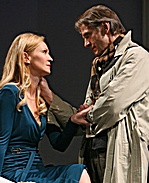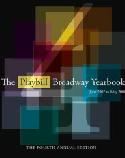SITE GUIDE
SEARCH
REVIEWS
REVIEW ARCHIVES
ADVERTISING AT CURTAINUP
FEATURES
NEWS
Etcetera and
Short Term Listings
LISTINGS
Broadway
Off-Broadway
NYC Restaurants
BOOKS and CDs
OTHER PLACES
Berkshires
London
California
New Jersey
Philadelphia
Elsewhere
QUOTES
TKTS
PLAYWRIGHTS' ALBUMS
LETTERS TO EDITOR
FILM
LINKS
MISCELLANEOUS
Free Updates
Masthead
A CurtainUp Review
Impressionism
By Elyse Sommer
|
Do you think life is intended to be Realism or Impressionism?.—Katharine.
I'm a photographer. Life is not only Realism, it's Photorealism.— Katharine's friend and employee. |

Joan Allen & Jeremy Irons in Impressionism
(Photo: Joan Marcus)
|
A hasty postscript to that first impression. Those eye popping intervals, notwithstanding, Irons and Allen are actually quite wonderful to watch — he as a photo journalist whose world travels seem to have come to a dead end, she as a more than slightly neurotic impressionist art specialist in whose gallery he now works.
If you had to label Impressionism with a genre identity, it would be as romantic comedy so this is not a play in which you'd expect to see Irons. Yet, he's delightful as Thomas Buckle, a man of a certain age, who seems to be suffering from the photographer's version of writer's block. Unlike one of the impressionist paintings that serve as playwright Michael Jacobs' thematic metaphor, Irons doesn't need to be viewed from a certain angle to appreciate his magnetic appeal and craggy good looks. You can visit the Museum of Modern Art and the Metropolitan Museum of Art to see originals of some of the gorgeous paintings of the Impressionist Era for less money and with enlightening audio tapes about the development of this style— but you can only see Jeremy Irons live on Broadway and it's a treat to have him back on Broadway after twenty-four years, even though it's in a play that's not even close to being on a par with Tom Stoppard's The Real Thing for which he won a Tony in 1984.
It's also good to have Joan Allen back who, like Irons, has been absent from the Broadway stage since the 1980s. Time has certainly been kind to her. She looks trim and gorgeous, a perfect model for the fashionable outfits trotted out for each scene, courtesy of Catherine Zuber. Though audiences are paying to see a play and not a fashion show the classy costumes, which include a drop dead outfit for Marsha Mason in a minor turn as a wealthy art patron, are one way for the actors to compete with the fabulous paintings that dominate Impressionism's eight scenes as well as those entertaining between scenes intervals.
But since we're not watching models on a fashion runway or ambling through a museum gallery, the question to be addressed is: What's wrong with this so appealingly cast and handsomely staged play? On the plus side, Michael Jacobs has neatly linked his rather pedestrian plot and his characters' hangups to the four key paintings popping up and down on Scott Pask's set — an art gallery that periodically metamorphoses into flashback locations, including Tanzania, Africa where Thomas's career came to a halt. on the minus side, the metaphoric connection lacks subtlety, substance and credible details.
The plot too obviously leads to an ending that will leave Katharine (Allen) and Thomas (Irons) less emotionally blocked once they're able to step back far enough to view not only art but their lives. Their individual stories somehow lack the needed power, originality and detail. Katharine's emotional problems are more clearly developed than Thomas's but there are Swiss cheese elements dogging both their stories (For example, how did she get the money to finance the gallery? How could Thomas afford to contemplate a long stay in the Riviera? What does she do on the laptop she opens each morning besides perhaps tweet about having just bought her Tuesday raspberry muffin?) As for the finale, the three visitors who arrive in the gallery in the penultimate scene wind things up amusingly enough, but it all makes for a clichéd and saccharine prelude to the happy ending that any follower of old-fashioned movies probably saw coming much earlier.
Of the subsidiary characters, Marsha Mason has the best part as the art collector whose impending grandmotherhood makes her determined to buy a Cassat mother and child painting for her daughter's home. Her comment that she should own it because she's "probably the last woman in America who has any money" is guaranteed to draw big, knowing laughs (a rewrite made during the extra tune-up period that delayed the play's official opening?). At any rate, like the other support players, as well as the two leads, Mason ably double tasks when one of the flashbacks calls for it.
Playwright Jacobs has been away from the Great White Way even longer than the two stars. However, unlike Irons and Allen, his last and only Broadway play (Cheaters, 1978), garnered no awards and closed after just 33 performances, prompting him to move on to a profitable career developing television series and films (notably Quiz Show). Consequently, this match of an unknown playwright with a top drawer director and cast is as much a puzzle as the real meaning about the relationship of the couple on a park bench in the play's most revealing painting. Director Jack O'Brien, who so ably created a vast theatrical canvas for the epic Coast of Utopia (review), was probably attracted to this play's attempt to connect a human story to the Impressionist Era that had such a powerful effect on the art world. The overlaps between the gallery world and some real paintings indeed bring to mind how in the first of that trilogy's plays O'Brien brilliantly used a real painting — Manet's famous tableau, "Dejeuners sur l'herbe." — to overlap a scene depicting the complicated relationships in philosopher Alexander Herzen's household. But Michael Jacobs is no Tom Stoppard and Impressionism is at best a minor pleasure rather than a major theatrical event.
|
Impressionism Playwright: Michael Jacobs Director: Jack O'Brien Cast: Stars Jeremy Irons (Thomas Burke) and Joan Allen (Katharine Keenan), with Marsha Mason (Julia Davidson), Hadley Delany (Young Katharine), André De Shields (/Chiambuane), Michael T. Weiss (Douglas Finch), Aaron Lazar (Ben Joplin) and Margarita Levieva (Nicole Halladay) Set design: Scott Pask Costume design: Catherine Zuber Lighting design: Natasha Katz Projection Design: Elaine JMcCarthy Sound design: Leon Rothenberg Hair and wig design: Tom Watson Original Music composed and performed by Bob James Stage Manager: Michael J. Passaro Running Time: Running Time: Approximately 1 hour and 40 minutes, with no intermission Gerald Shoenfeld Theater 236 West 45th Street From 2/28/09; opening 3/24/09; closing 5/10/09 Reviewed by Elyse Sommer at 3/20/09 press performance |
|
REVIEW FEEDBACK Highlight one of the responses below and click "copy" or"CTRL+C"
Paste the highlighted text into the subject line (CTRL+ V): Feel free to add detailed comments in the body of the email. . .also the names and emails of any friends to whom you'd like us to forward a copy of this review. You can also contact us at Curtainup at Facebook or Curtainup at Twitter |
Try onlineseats.com for great seats to
Wicked
Jersey Boys
The Little Mermaid
Lion King
Shrek The Musical

South Pacific

In the Heights

Playbill 2007-08 Yearbook

Leonard Maltin's 2008 Movie Guide


Wicked
Jersey Boys
The Little Mermaid
Lion King
Shrek The Musical

South Pacific

In the Heights

Playbill 2007-08 Yearbook

Leonard Maltin's 2008 Movie Guide


